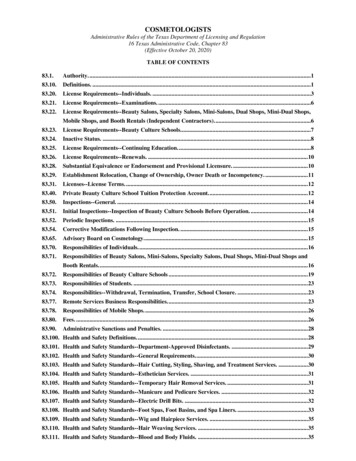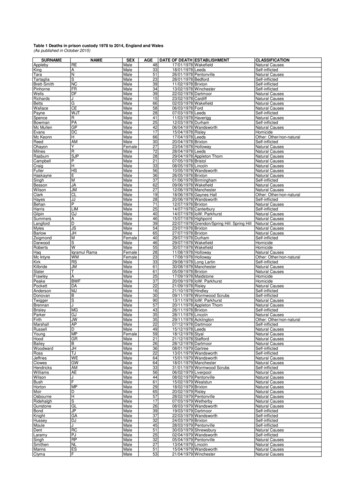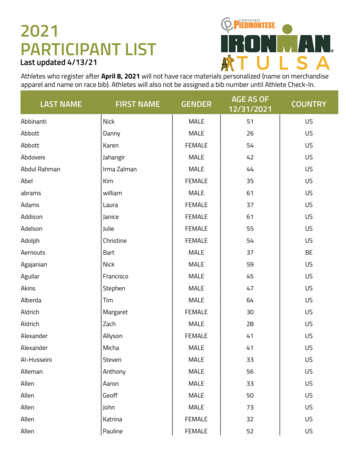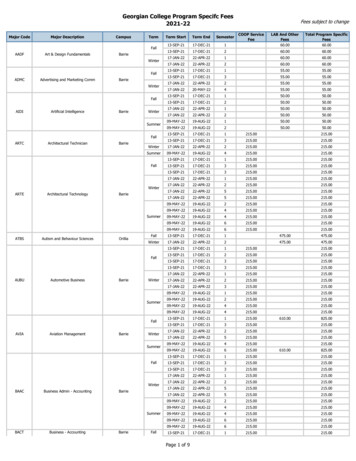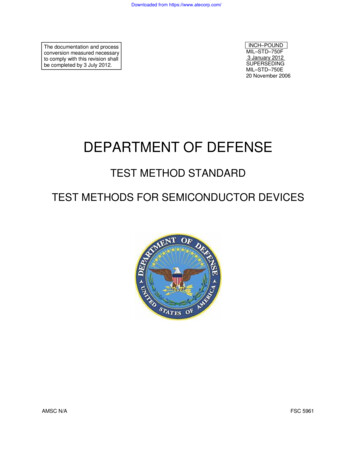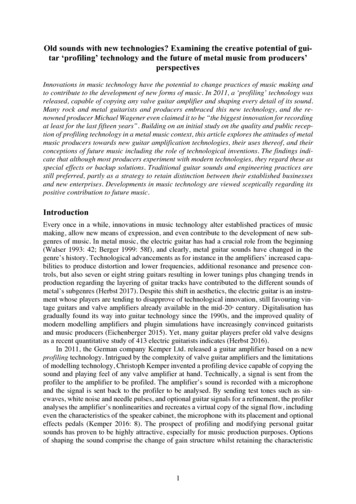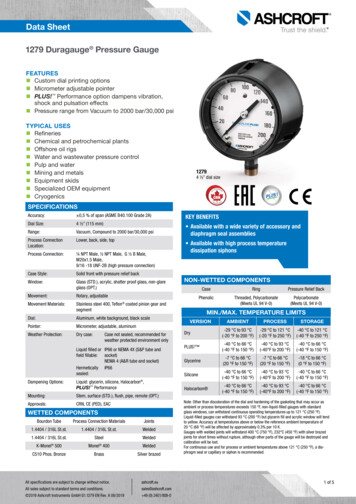
Transcription
United StatesEnvironmental ProtectionAgencyOffice of WaterWashington, D.C. 20460EPA 821-R-01-029April 2001Method 1602: Male-specific (F ) andSomatic Coliphage in Water by SingleAgar Layer (SAL) ProcedureApril 2001
AcknowledgmentsThis method was prepared under the direction of William A. Telliard of the Engineering and AnalysisDivision within the U.S. Environmental Protection Agency’s (EPA) Office of Water. The EPA technicallead was Paul Berger, of the Standards and Risk Management Division within the Office of Water. Thisdocument was prepared under EPA Contract No. 68-C-98-139 by DynCorp Information & EnterpriseTechnology, Inc.The contributions of the following persons and organizations to the development of this method aregratefully acknowledged:Sobsey, Mark, Ming Jing Wu, and Greg Lovelace, University of North Carolina, Department ofEnvironmental Sciences and Engineering, CB#7400, McGavran-Greenberg Building, Chapel Hill,NC 27599Hsu, Fu-Chih, and Jim Larkin, Environmental Health Laboratories, 110 South Hill Street, South Bend, IN46617Chambers, Yildiz, City of San Diego Marine Microbiology Laboratory, 5530 Kiowa Drive, La Mesa, CA91942Cliver, Dean, Tadesse Mariam, and Mulugeta Tamene, University of California Davis, Department ofHealth and Reproduction, School of Veterinary Medicine, Davis, CA 95616-8743Danielson, Richard, BioVir Laboratory, 685 Stone Road Unit # 6, Benicia, CA 94510Fujioka, Roger and Geeta Rijal, University of Hawaii, Water Resources Center, Holmes Hall 283, 2540Dole Street, Honolulu, HI 96822Karim, Mohammad and Dale Young, American Water Works System Research Laboratory, 1115 SouthIllinois Street, Belleville, IL 62220-3731Margolin, Aaron and Nicola Ballester, University of New Hampshire, Department of Microbiology,Biological Sciences Building, Rudman Hall Room 285, Durham, NH 03824Pillai, Suresh and Elisa Camacho, Texas A & M University, Department of Poultry Science, KlebergCenter Room 418D, College Station, TX 77843Pope, Misty, Kevin Connell, Jason Kempton, Ken Miller, and Jessica Pulz, DynCorp Information andEnterprise Technologies, 6101 Stevenson Avenue, Alexandria, VA 22304Williams, Fred and Ron Stetler U.S. Environmental Protection Agency, 26 West Martin Luther KingDrive, Cincinnati, OH, 45268Yates, Marylynn, Omid Bakhtar, and Andre Salazar, University of California Riverside, Department ofEnvironmental Sciences, 2217 Geology, Riverside, CA 92521-0424i
DisclaimerMention of trade names or commercial products does not constitute endorsement or recommendation foruse.ii
IntroductionColiphage presence in ground water is an indication of fecal contamination. Method 1602 is a performancebased method for enumerating male-specific (F ) and somatic coliphage in ground water and other waters.Laboratories are permitted to modify or omit any steps or procedure, with the exception of the coliphagestock enumeration procedure (Section 11.3), provided that all performance requirements set forth in thevalidated method are met. The laboratory may not omit any quality control analyses.This single agar layer procedure requires the addition of host bacteria, magnesium chloride, and doublestrength molten agar medium to the sample, followed by pouring the total volume of the mixture into plates.All plates from a single sample are examined for plaque formation (zones of bacterial host lawn clearing).The quantity of coliphage in a sample is expressed as plaque forming units (PFU) / 100 mL.This method is for use in the Environmental Protection Agency’s (EPA’s) data gathering and monitoringprograms under the Safe Drinking Water Act and the Clean Water Act.Questions concerning this method or its application should be addressed to:William A. TelliardU.S. EPA Office of WaterAnalytical Methods Staff1200 Pennsylvania NWMail Code 4303Washington, DC 20460Email: telliard.william@epa.govRequests for additional copies of this publication should be directed to:Water Resource CenterMail Code RC-4100401 M Street, SWWashington, D.C. 20460(202) 260-7786 or (202) 260-2814iv
Table of Contents1.0Scope and Application . . . . . . . . . . . . . . . . . . . . . . . . . . . . . . . . . . . . . . . . . . . . . . . . . . . . . . . . 12.0Summary of Method . . . . . . . . . . . . . . . . . . . . . . . . . . . . . . . . . . . . . . . . . . . . . . . . . . . . . . . . . 13.0Definitions . . . . . . . . . . . . . . . . . . . . . . . . . . . . . . . . . . . . . . . . . . . . . . . . . . . . . . . . . . . . . . . . 14.0Interferences . . . . . . . . . . . . . . . . . . . . . . . . . . . . . . . . . . . . . . . . . . . . . . . . . . . . . . . . . . . . . . . 25.0Safety . . . . . . . . . . . . . . . . . . . . . . . . . . . . . . . . . . . . . . . . . . . . . . . . . . . . . . . . . . . . . . . . . . . . 26.0Equipment and Supplies . . . . . . . . . . . . . . . . . . . . . . . . . . . . . . . . . . . . . . . . . . . . . . . . . . . . . . 37.0Reagents and Standards . . . . . . . . . . . . . . . . . . . . . . . . . . . . . . . . . . . . . . . . . . . . . . . . . . . . . . . 48.0Sample Collection, Preservation, and Storage . . . . . . . . . . . . . . . . . . . . . . . . . . . . . . . . . . . . . . . 99.0Quality Control . . . . . . . . . . . . . . . . . . . . . . . . . . . . . . . . . . . . . . . . . . . . . . . . . . . . . . . . . . . . 1010.0Calibration and Standardization . . . . . . . . . . . . . . . . . . . . . . . . . . . . . . . . . . . . . . . . . . . . . . . . 1511.0Enumeration of Coliphage QC Spiking Suspensions . . . . . . . . . . . . . . . . . . . . . . . . . . . . . . . . . 1512.0Single Agar Layer (SAL) Procedure for Sample Analysis . . . . . . . . . . . . . 1813.0Data Analysis and Calculations . . . . . . . . . . . . . . . . . . . . . . . . . . . . . . . . . . . . . . . . . . . . . . . . 2014.0Method Performance . . . . . . . . . . . . . . . . . . . . . . . . . . . . . . . . . . . . . . . . . . . . . . . . . . . . . . . . 2215.0Pollution Prevention . . . . . . . . . . . . . . . . . . . . . . . . . . . . . . . . . . . . . . . . . . . . . . . . . . . . . . . . 2316.0Waste Management . . . . . . . . . . . . . . . . . . . . . . . . . . . . . . . . . . . . . . . . . . . . . . . . . . . . . . . . . 2317.0References . . . . . . . . . . . . . . . . . . . . . . . . . . . . . . . . . . . . . . . . . . . . . . . . . . . . . . . . . . . . . . . . 2418.0Flowcharts . . . . . . . . . . . . . . . . . . . . . . . . . . . . . . . . . . . . . . . . . . . . . . . . . . . . . . . . . . . . . . . 2519.0Glossary . . . . . . . . . . . . . . . . . . . . . . . . . . . . . . . . . . . . . . . . . . . . . . . . . . . . . . . . . . . . . . . . . 29vi
Method 1602: Male-specific (F ) and Somatic Coliphage inWater by Single Agar Layer (SAL) ProcedureApril 20011.0Scope and Application1.1The single agar layer (SAL) procedure detects and enumerates male-specific (F ) and somaticcoliphages in ground water and other waters. This method is intended to help determine if groundwater is affected by fecal contamination.1.2Although this method may be used for water matrices other than ground water, it has only beenvalidated for use in ground water.1.3This method is based on procedures developed for the determination of coliphage in water in theSupplement to the 20th Edition of Standard Methods for the Examination of Water andWastewater (Reference 17.1).1.4This method is not intended for use in biosolids samples or as a test for microorganisms other thancoliphage. This method may be used in ground water and other water matrices where coliphage issuspected to be present.1.5Each laboratory and analyst that uses this method must first demonstrate the ability to generateacceptable results using the procedures in Section 9.0.1.6Any modification of the method beyond those expressly permitted is subject to the application andapproval of alternate test procedures under 40 CFR parts 136.4 and 136.5, and/or 141.27.2.0Summary of Method2.1Method 1602 describes the single agar layer (SAL) procedure. A 100-mL ground water sample isassayed by adding MgCl2 (magnesium chloride), log-phase host bacteria (E. coli Famp for F coliphage and E. coli CN-13 for somatic coliphage), and 100 mL of double-strength molten trypticsoy agar to the sample. The sample is thoroughly mixed and the total volume is poured into 5 to 10plates (dependent on plate size). After an overnight incubation, circular lysis zones (plaques) arecounted and summed for all plates from a single sample. The quantity of coliphage in a sample isexpressed as plaque forming units (PFU) / 100 mL. For quality control purposes, both a coliphagepositive reagent water sample (OPR) and a negative reagent water sample (method blank) areanalyzed for each type of coliphage with each sample batch.3.0Definitions3.1Coliphages are viruses (bacteriophages) that infect E. coli and are indicators of fecalcontamination. This method is capable of detecting two types of coliphages: male-specific (F ) andsomatic.3.2F-factor is the fertility factor in certain strains of E . coli. It is a plasmid that, when present, codesfor pilus formation. The pilus allows for transfer of nucleic acid from one bacterium to another.1April 2001
Method 1602: Single Agar Layer (SAL) Procedure3.3Male-specific coliphages (F ) are RNA or DNA viruses that infect via the F-pilus of male strainsof E. coli.3.4Somatic coliphages are DNA viruses that infect host cells via the outer cell membrane.3.5Definitions for other terms used in this method are given in the glossary in Section 19.3.4.0Interferences4.1During the single agar layer procedure the sample and host bacteria should not remain in contactwith each other for more than 10 minutes prior to plating and after plating the agar must hardenwithin 10 minutes. Increased contact time or agar hardening time may result in replication ofphages such that the initial phage concentration is overestimated. The entire plating procedure fromcombining sample with host to hardening of single-agar layer plates should not exceed 20 minutes.5.0Safety5.1The biohazards and the risk of infection by pathogens associated with handling raw sewage arehigh in this method. Use good laboratory practices when working with potentially harmful samples.5.2Method 1602 does not purport to address all of the safety problems associated with its use. It is theresponsibility of the laboratory to establish appropriate safety and health practices prior to use ofthis method. The analyst/technician must know and observe the safety procedures required in alaboratory that handles biohazardous material while preparing, using, and disposing of cultures,reagents, and materials. The analyst/technician must use proper safety procedures while operatingsterilization equipment. Equipment and supplies that have come into contact with biohazardousmaterial or are suspected of containing biohazardous material must be sterilized prior to disposalor re-use. Field and laboratory staff collecting and analyzing environmental samples are undersome risk of exposure to pathogenic microorganisms. Staff should apply safety procedures used forhandling pathogens to all samples.5.3The laboratory is responsible for maintaining a current awareness file of Occupational Safety andHealth Administration (OSHA) regulations regarding the safe handling of the chemicals specifiedin this method. A reference file of material safety data sheets should be made available to allpersonnel involved in these analyses. Additional information on laboratory safety can be found inSection 16.0 Waste Management.5.4Samples may contain high concentrations of biohazardous agents and must be handled with gloves.Any positive reference materials also must be handled with gloves in an appropriate laboratoryhood. The analyst/technician must never place gloves near the face after exposure to media knownor suspected to contain pathogenic microorganisms. Laboratory personnel must change gloves afterhandling raw sewage or any other items which may carry pathogenic microorganisms.5.5Mouth pipetting is prohibited.April 20012
Method 1602: Single Agar Layer (SAL) Procedure6.0Equipment and SuppliesPlease note: Brand names, suppliers, and part numbers are for illustrative purposes only. Noendorsement is implied. Equivalent performance may be achieved using apparatus and materials otherthan those specified in this section, but demonstration of equivalent performance that meets therequirements of this method is the responsibility of the laboratory.6.1Equipment for collection and transport of samples6.1.1Bottles for collection of water—Sterile, wide-mouth, polypropylene, 4-L (or smaller)bottles or carboys with screw caps6.1.2Ice chest—Igloo, Coleman, styrofoam box or equivalent6.1.3Ice6.1.3.1 Wet ice—purchased locally, or6.1.3.2 Ice packs—Blue Ice, UTek cat. no. 429, or equivalent, frozen for use6.1.46.2Bubble wrapEquipment and supplies for growth of microorganisms6.2.1Sterile dilution tubes with screw caps—Reusable or disposable, 16 150 mm, or16 100 mm6.2.2Test tube rack—Size to accommodate tubes specified in Section 6.2.16.2.3Glass or plastic, plugged, sterile serological pipettes—To deliver, of appropriatevolume(s) (Falcon, Kimble, or equivalent)6.2.4Pipet bulbs, automatic pipetter—Pipet-Aid or equivalent6.2.5Inoculation loops—Nichrome or platinum wire, disposable, sterile plastic loops, or woodenapplicator, at least 3 mm in diameter or 10 µL volume (VWR, Fisher, DIFCO, orequivalent)6.2.6Micropipettors, adjustable—10- to 200-µL, and 100- to 1000-µL, with appropriateaerosol resistant tips, Gilson, Eppendorf, or equivalent. Please note: To avoid crosscontamination, micropipettors should be wiped down with a 1 : 100 solution ofhousehold bleach followed by a 10% solution of sodium thiosulfate. Alternatively,disposable pipets (Serological, Pasteur, or equivalent) may be used.6.2.7Burner—Alcohol, Bunsen, Fisher, or equivalent6.2.8Sterile disposable petri dishes—100-mm -diameter dishes (Falcon # 1029) or150-mm-dishes (Falcon #1058) or equivalent6.2.9Incubator capable of maintaining 36 C 1.0 C for growth of microorganisms6.2.10 Beakers—2- and 4-L, sterile, polypropylene, glass, or polycarbonate6.2.11 Polypropylene, glass, or polycarbonate bottles—Wide-mouth, 100-mL or 1-L, square orround, autoclavable with screw cap6.2.12 Erlenmeyer flasks—1-L and 2-L, sterile, Corning, Nalgene, Kimble or equivalent6.2.13 Stir bar—Fisher cat. no. 14-511-93, or equivalent6.2.14 Stir plate—Fisher cat. no. 14-493-120S, or equivalent6.2.15 Water bath capable of maintaining 36 C 1.0 C and 45 C to 48 C —Precision, VWRScientific, or equivalent3April 2001
Method 1602: Single Agar Layer (SAL) Procedure6.2.16 Sterilization filtration equipment—Millex type for syringe or larger Millipore type, sterile,0.22-µm pore size6.2.17 Sterile, cotton-tipped applicators6.2.18 Latex gloves for handling samples, supplies, and equipment—Microflex, San Francisco,CA, stock no. UL-315-L, or equivalent6.2.19 pH meter—Beckman, Corning, or equivalent6.2.20 Vortex mixer—Vortex Genie, or equivalent6.2.21 Spectrophotometer or colorimeter (with wavelengths in visible range)—Spectronic 20,Spectrum Instruments, Inc., or equivalent, with cell holder for ½" diameter cuvettes(Model # 4015) or 13 mm 100 mm cuvettes6.2.22 Cuvettes—1-cm light path, Beckman, Bausch and Lomb, or equivalent6.2.23 Shaker flasks—Fluted Erlenmeyer,125-mL with slip cap or sterile plug, Fisher(09-552-33, 10-140-6, 10-041-5A) or equivalent or equivalent6.2.24 Shaker incubator—Capable of 36 C 1.0 C and 100 to 150 rpm, New Brunswick,PsychoTherm, Innova, or equivalent or an ordinary shaker in an incubator6.2.25 Flask weights—VWR 29700-004 or equivalent6.36.4Supplies for collection and filtration of raw sewage (Section 7.4.3)6.3.1Disposable filter disks—25-mm-diameter, 0.45-µm pore size, sterile, low protein binding(Gelman Acrodisc HT Tuffryn, No. 4184, cellulose acetate Corning No. 21053-25, orequivalent)6.3.2Syringes—Sterile, disposable, 5-,10-, or 20-mL6.3.3Polypropylene dilution tubes—Sterile, 10- to 20-mL, Falcon or equivalent6.3.4Sterile glass or polypropylene 250-mL bottles for collection of raw sewageMiscellaneous lab ware and supplies6.4.1Lint-free tissues—KimWipes or equivalent6.4.2Weigh boats6.4.3Graduated cylinders—Sterile, polypropylene or glass, 100-mL, 250-mL, and 1-L6.4.4Autoclave6.4.5Thermometers—Range of 0 C to 100 C6.4.6Balance—Capable of weighing to 0.1 mg for samples having a mass up to 200 g6.4.7Freezer vials—Sterile, 5-mL screw cap, Nunc or equivalent6.4.8Light box—VWR 21475-460 or equivalent7.0Reagents and Standards7.1General reagents7.1.1Reagent water—Should conform to Specification D 1193, Annual Book of ASTMStandards (Reference 17.5).7.1.210% (w/v) Sodium thiosulfate—Add 10 g sodium thiosulfate (Na2S2O3) per 90 mL reagentwater. Mix until dissolved. Bring to a final volume of 100 mL and autoclave for 15minutes at 121 C and 15 psi.April 20014
Method 1602: Single Agar Layer (SAL) Procedure7.27.1.3Stock magnesium chloride (80X, 4M)—To 814 g of MgCl2 6H2O, add 300 mL reagentgrade water. Stir to dissolve. Bring to a final volume of 1 L, and mix thoroughly.Autoclave for 15 minutes at 121 C and 15 psi.7.1.4Glycerol—Sigma #G6279 or equivalent. Autoclave for 15 minutes at 121 C and 15 psi.Remove promptly to avoid scorching. Store at room temperature.7.1.5Household bleach7.1.6Ethanol—70% or greaterAntibiotic stocks—Antibiotics must always be added to medium after the medium has beenautoclaved.7.2.1Stock nalidixic acid (Sigma N4382, or equivalent)—Please note: Nalidixic acid isconsidered toxic. Wear suitable protective clothing, gloves, and eye/face protection anduse in a chemical fume hood.7.2.1.1 For growth of E. coli CN-13, the host bacteria for somatic coliphage.7.2.1.2 Dissolve 1 g of nalidixic acid sodium salt in 100 mL reagent water. Filterthrough a sterile, 0.22-µm-pore-size membrane filter assembly. Dispense 5 mLper 5-mL freezer vial, date vial, and store frozen at -20 C for up to one year.Thaw at room temperature or rapidly in a 36 C 1.0 C water bath. Mix wellprior to use.7.2.2Stock ampicillin/streptomycin7.2.2.1 For growth of E. coli Famp, the host bacteria for male-specific coliphage.7.2.2.2 Dissolve 0.15 g of ampicillin sodium salt (Sigma A9518) and 0.15 gstreptomycin sulfate (Sigma S6501) in 100 mL of reagent water. Filter througha sterile 0.22-µm-pore-size membrane filter assembly. Dispense 5 mL per5-mL freezer vial, date vial, and store frozen at -20 C for up to one year. Thawprior to use at room temperature or rapidly in a 36 C 1.0 C water bath. Mixwell prior to use.7.3Media7.3.1Tryptic (or trypticase) soy broth (TSB)—(DIFCO 0370-15-5, or equivalent)7.3.1.1 TSB—Follow procedure as specified on bottle of media. If dehydrated mediumis not available, prepare the media by adding 17.0 g of tryptone, 3.0 g ofsoytone, 2.5 g of dextrose, 5.0 g of sodium chloride, and 2.5 g of dipotassiumphosphate to 1L of reagent water and heat to dissolve. Adjust pH to 7.3 with1.0 N hydrochloric acid or 1.0 N sodium hydroxide, if necessary. Autoclave at121 C and 15 psi for 15 minutes. Check pH again after autoclaving byaseptically removing an aliquot of medium. Adjust pH as necessary. Discardaliquot after checking pH, to ensure that the medium is not contaminated.7.3.1.2 TSB with nalidixic acid (for growth of E. coli CN-13)—Aseptically add 10 mLof stock nalidixic acid (Section 7.2.1) to 1 L of autoclaved, cooled(48 C 1.0 C) TSB (Section 7.3.1.1) and mix. Please note: Antibiotics mustalways be added to medium after the medium has been autoclaved and cooled.7.3.1.3 TSB with streptomycin/ampicillin (for growth of E. coli Famp )—Aseptically add10 mL of stock streptomycin/ampicillin sulfate (Section 7.2.2) to 1 L ofautoclaved, cooled (48 C 1.0 C) TSB (Section 7.3.1.1) and mix. Please note:5April 2001
Method 1602: Single Agar Layer (SAL) ProcedureAntibiotics must always be added to medium after the medium has beenautoclaved and cooled.7.3.21.5% tryptic soy agar (TSA)—To be used in streak plates (Section 7.5.2.1) and asbottom layer of agar (Section 11.3.1.3) during the double agar layer (DAL) coliphagestock QC sample spiking suspension enumeration procedure. Prior to autoclaving the TSBwithout antibiotics, prepared as described in Section 7.3.1.1, add 15 g of agar per liter ofTSB. While stirring, heat to dissolve agar. Autoclave for 15 minutes at 121 C and 15 psi.Cool to 48 C 1.0 C and mix molten medium well to ensure even distribution.7.3.2.1 For growth of somatic coliphages using E. coli CN-13 as host bacteria,aseptically add 10 mL of stock nalidixic acid (Section 7.2.1) per liter ofautoclaved 1.5% TSA (Section 7.3.2). Please note: Antibiotics must always beadded to medium after the medium has been autoclaved and cooled. Swirlflask until well mixed and aseptically dispense 17 - 18 mL per 100-mm plate.Allow to solidify with lids off in a biohazard hood for several minutes prior touse. If not used immediately, replace lids and store inverted at 4 C 1 C for upto 2 weeks.7.3.2.2 For growth of male-specific (F ) coliphages using E. coli Famp as host bacteria,aseptically add 10 mL stock ampicillin/streptomycin sulfate (Section 7.2.2) perliter of autoclaved 1.5% TSA (Section 7.3.2). Please note: Antibiotics mustalways be added to medium after the medium has been autoclaved and cooled.Swirl flask until well mixed and aseptically dispense 17 - 18 mL per 100-mmplate. Allow to solidify with lids off in a biohazard hood for several minutesprior to use. If not used immediately, replace lids and store inverted at4 C 1 C for up to 2 weeks.7.3.30.7% tryptic soy agar (TSA)—“Soft” agar for use as the top layer of agar (Section11.3.1.1) during the double agar layer (DAL) coliphage stock QC sample spikingsuspension enumeration procedure. Prior to autoclaving the TSB without antibiotics,prepared as described in Section 7.3.1.1, add 7 g of agar per liter of TSB. While stirring,heat to dissolve agar. Autoclave for 15 minutes at 121 C and 15 psi. Cool to48 C 1.0 C.7.3.3.1 0.7% TSA top agar tubes with nalidixic acid (for growth of E. coli CN13)—To 1 L of autoclaved 0.7% TSA (soft agar) (Section 7.3.3), asepticallyadd 10 mL of stock nalidixic acid (Section 7.2.1). Please note: Antibiotics mustalways be added to medium after the medium has been autoclaved and cooled.Dispense 5 mL per sterile 10-mL tube, label, and keep at 45 C to 48 C untiluse. Tubes must be used the day they are prepared.7.3.3.2 0.7% TSA top agar tubes with ampicillin/streptomycin (for growth ofE. coli Famp)—To 1 L of autoclaved 0.7% TSA (soft agar) (Section 7.3.3),aseptically add 10 mL of stock ampicillin/streptomycin (Section 7.2.2). Pleasenote: Antibiotics must always be added to medium after the medium has beenautoclaved and cooled. Dispense 5 mL per sterile 10-mL tube, label, and keepat 45 C to 48 C until use. Tubes must be used the day they are prepared.7.3.4Single agar layer7.3.4.1 Double-strength tryptic soy agar (2X TSA)—Double all components of TSBwithout antibiotics from Section 7.3.1.1 (except reagent water) and add 18 g ofagar per liter. Heat to dissolve while stirring. Autoclave for 15 minutes at121 C and 15 psi. Cool to 48 C 1.0 C. After autoclaving, swirl to mix.April 20016
Method 1602: Single Agar Layer (SAL) ProcedureMedium may become darker after autoclaving but this should not impact mediaperformance.7.3.4.2 2X TSA with nalidixic acid (for growth of E. coli CN-13)—To 1 L ofautoclaved 2X TSA, aseptically add 20 mL of stock nalidixic acid (Section7.2.1) and mix well. Please note: Antibiotics must always be added to mediumafter the medium has been autoclaved and cooled. Keep molten at45 C to 48 C in water bath until use. Agar must be used on the day ofpreparation.7.3.4.3 2X TSA with ampicillin/streptomycin (for growth of E. coli Famp)—To 1 L ofautoclaved 2X TSA, aseptically add 20 mL of stock ampicillin/streptomycin(Section 7.2.2) and mix well. Please note: Antibiotics must always be added tomedium after the medium has been autoclaved and cooled. Keep molten at45 C to 48 C in water bath until use. Agar must be used on the day ofpreparation.7.3.5Spot plates—To be used during the plaque confirmation procedure (Section 12.6). Pleasenote: Condensation may accumulate at the edges of stored spot plates and may drip overagar surface if tilted, ruining the spot pattern. If the stored spot plates havecondensation, incubate plates for approximately 10 minutes to eliminate condensationprior to inoculation.7.3.5.1 Log-phase host bacteria must be prepared in advance (Section 7.5.4). Dissolve3 g TSB (Section 7.3.1.1) and 0.75 g bacteriological grade agar per 100 mL ofreagent grade water. Heat and mix to dissolve. Autoclave for 15 minutes at121 C and 15 psi. Cool to 45 C to 48 C in a water bath.7.3.5.2 Add 2 mL of log-phase host bacterium prepared as directed in Section 7.5.4 and1 mL stock antibiotic (Section 7.2). Please note: Antibiotics must always beadded to medium after the medium has been autoclaved and cooled. Nalidixicacid is used with E. coli CN-13, and ampicillin/streptomycin is used withE. coli Famp. Swirl to mix, and pour 20 mL per 100-mm diameter, sterile petriplate. Allow to solidify. Label plates with name of host bacterium. Plates maybe used that day or stored at 4 C 1 C for up to four days before use. Dividethe bottom of the plate into a grid of 1-cm squares using a permanent markingpen. Number each square for ease of reference. Other alternatives include: 1)gridded petri dishes, 2) adhesive grids, or 3) creating the 1-cm grid on a circularplastic dish and attaching to the bottom exterior of the plate with cellophanetape.7.4Coliphage stock7.4.1MS2 stock coliphage (ATCC#15597-B1)—Male-specific (F ) coliphage. Refer gy.cfm#q10 for initial preparation of coliphagestock. May be stored at 2 C to 8 C for up to 5 years.7.4.2phi-X 174 stock coliphage (ATCC#13706-B1)—Somatic coliphage. Refer gy.cfm#q10 for initial preparation of coliphagestock. May be stored at 2 C to 8 C for up to 5 years.7.4.3Coliphage stock from sewage filtrate—This filtrate will be used as a spiking suspensionfor QC samples.7.4.3.1 Collect approximately 100 mL of raw sewage in a 250-mL collection bottle.7April 2001
Method 1602: Single Agar Layer (SAL) Procedure7.4.3.2 Transport to the laboratory on ice. Analysis of raw sewage filtrate should beginwithin 24 hours of collection.7.4.3.3 Allow the raw sewage to settle at 4 C 1 C for 1 to 3 hours. This will make thefiltration process easier.7.4.3.4 Remove a sterile, 20-mL syringe from its package, aseptically remove plungerfrom barrel, and attach a filter disk to the syringe barrel.7.4.3.5 Pipet 10 to 15 mL of supernatant from settled sewage into the syringe barrel.7.4.3.6 Hold the assembly over a sterile 15-mL polypropylene tube with screw-cap orsnap-cap, insert the plunger into the syringe barrel, and push the sewage throughthe filter into the sterile tube. If filter clogs, change it as necessary and continueto filter sewage until at least 10 mL of filtered sewage is obtained in the 15-mLpolypropylene tube (filtration may require use of numerous filters).7.4.3.7 Cap the tube, label with source, date, and initials, and store the filtrate at4 C 1 C until ready to assay. If filtrate is stored more than 24 hours, it mustbe re-titered before use.7.5Host bacteria stock cultures7.5.1Pure host bacteria cultures7.5.1.1 E. coli CN-13 (somatic coliphage host)—Nalidixic acid–resistant mutant ofE. coli C; originated by Pierre Payment, Institute Armand Frappier, Universityof Quebec, Montreal, Canada, frozen stock. ATCC#700609.7.5.1.2 E. coli Famp— E. coli HS(pFamp)R (male-specific coliphage host)—originatedby Victor Cabelli, formerly of the Department of Microbiology, University ofRhode Island, Kingston, RI, USA, frozen stock. ATCC#700891.7.5.2Frozen host bacteria stock cultures—The laboratory shall obtain reference host bacterialcultures (Sections 7.5.1.1 and 7.5.1.2) and use these to establish pure frozen host stockcultures that are maintained by the laboratory. Frozen stocks are used as inoculum forovernight host bacteria stock cultures (Section 7.5.3).7.5.2.1 Establish pure frozen stock cultures by streaking host bacteria onto 1.5% TSAplates with appropriate antibiotic (Section 7.3.2) to attain isolated colonies.7.5.2.2 Incubate inoculated plates overnight, pick an individual colony and inoculateinto tryptic soy broth with appropriate antibiotics (Sections 7.3.1.2 and 7.3.1.3),and grow to log phase (Section 7.5.4).7.5.2.3 Harvest broth by mixing sterile glycerol and broth with log-phase host bacteriain a ratio of 1:4 in a 5-mL freezer vial. Prepare log-phase host bacteria asdescribed in Section 7.5.4, below. (Example: 200 µL sterile glycerol plus800 µL log-phase E. coli).7.5.2.4 Label with E. coli strain and date of harvest.7.5.2.5 Freeze host bacteria stock cultures at -70 C, if possible. Cultures can be frozenat -20 C if the laboratory does not have the capability to freeze samples at-70 C).7.5.2.6 Host bacteria stored at -70 C may be retained for up to one year. If stored at-20 C, the host bacteria may be retained for up to two months.7.5.3April 2001Overnight host bacteria stock cultures—Inoculum from an overnight bacterial hostculture will reach log-phase more rapidly than inoculum from frozen stock.8
Method 1602: Single Agar Layer (SAL) Procedure7.5.3.1 Dispense 25 mL of tryptic soy broth (TSB) with nalidixic acid (Section 7.3.1.2)into a sterile 125-mL shaker flask. For proper growth conditions, each flaskshould always contain 25 to 30 mL of medium.7.5.3.2 Inoculate the flask with a loopful of E. coli CN-13 from the frozen stock culture(Section 7.5.2).7.5.3.3 Repeat Sections 7.5.3.1 and 7.5.3.2 using TSB with streptomycin/ampicillin asthe medium (Section 7.3.1.3) and E. coli Famp as the bacterial host.7.5.3.4 Place a sterile slip cap or plug on the shaker flasks, label flasks, and s
1.2 Although this method may be used for water matrices other than ground water, it has only been validated for use in ground water. 1.3 This method is based on procedures developed for the determination of coliphage in water in the Supplement to the 20 th Edition of Standard Methods for the Examination of Water and Wastewater (Reference 17.1).

